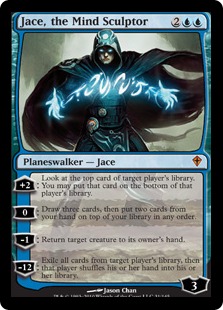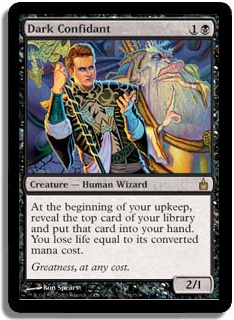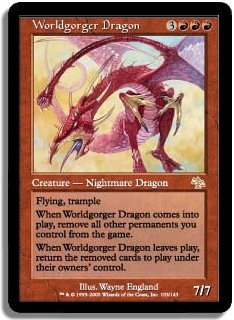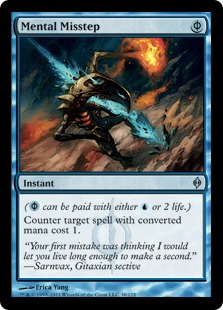Summer, the Eternal Season
With spring in full swing and summer right around the corner, one thing is for certain: “It’s beginning to look a lot like Eternal
Season…”
If you are anything like me (a Legacy and Vintage super-fan), you probably already know that with regard to awesome Eternal tournaments, summertime is
king. The Legacy Grand Prix in Providence, the StarCityGames.com Invitational, and the Vintage Championships are all examples of marquee Eternal events
we as gamers have to look forward to in the near future.
And I, personally, could not be more excited about having the opportunity to play in the biggest and most competitive North American Legacy and Vintage
events of the year in the upcoming summer months.
With all of that being said, it’s time to move on to the topic at hand, which is a discussion of the how, what, and why for the current dominance of
blue decks in Eternal.
Blue, the Eternal Color
Recent tournament results from SCG Orlando and the Blue Bell Game Day Vintage #15 suggests that various types of blue decks are firmly perched atop
both the Legacy and Vintage metagames.
I am well aware (as is anybody who knows me) that I have an obvious bias toward blue decks in Constructed Magic, particularly in Eternal formats. A
preference for blue decks in Eternal is basically a predisposition toward winning with a higher frequency.
People shouldn’t really be too shocked that blue has always been the best, is the best, and always will be the best in Vintage, since it has had
Ancestral Recall and Time Walk (the two best non Black Lotus/Time Vault spells ever printed) right from the start.
Sure, there are other decks in Vintage and they win sometimes—but the metagame power of these decks basically comes from the fact that the
hardest matchup for a blue deck is another blue deck—and the fact that blue decks (Dark Ritual or Mana Drain varieties) must play an
overabundance of cards to interact with spells on the stack, instead of cards that interact with dumb 5/3s and 5/5s.
Here is the joke—which is also the down-to-earth truth—if a blue deck wants to beat a Workshop deck, Dredge deck, or creature deck, it can
do so very easily. By simply adding 3-5 cards to a player’s Mana Drain deck, that deck can beat Mishra’s Workshop 80% of the time,
and the same can be said about any other matchup blue Time Vault decks might face (excluding, of course, other blue decks).
There is no equivalent that a Workshop deck can use to hedge its percentages against a blue deck—basically, not-blue decks simply rely on the
fact that blue decks need lots of their deck geared towards beating other blue decks and that a blue mage simply won’t have enough relevant cards
to interact with the board.
In Legacy, there was hope that all of the other colors combined might have a chance at being as good as blue; after all, everything else didn’t
have to compete with Ancestral Recall and Time Walk—they merely had to try and equal Brainstorm and Force of Will. While Ancestral Recall and
Time Walk are pretty clearly better than every other Constructed Magic card, as the dust settles in Legacy, it may simply turn out that Brainstorm and
Force of Will are similarly better than everything in that format.
Only time will tell—but as things are shaping up, an important new printing, Mental Misstep, may simply have put various blue decks over the
edge. The one saving grace may end up being that the only bad matchup blue decks really have are other blue decks, which will skew the way that blue
decks are constructed and give other colors/decks a chance (the same way that I explained this phenomenon working in Vintage with regard to Time Vault
decks and Workshop decks).
Jace, the Mind Sculptor weighs in on Vintage: “Here I rule.”
I have been pushing the Vintage Control deck for months now, but I truly believe it is the best-positioned deck in Vintage by a wide margin. At Blue
Bell this weekend, Vintage fan Joe Brown piloted the deck to a top 4 finish—also, he was the only player in the 60-plus-player field playing
Vintage Control.
Creatures (1)
Planeswalkers (3)
Lands (15)
Spells (41)
- 2 Sensei's Divining Top
- 1 Brainstorm
- 3 Mana Drain
- 1 Vampiric Tutor
- 1 Mystical Tutor
- 1 Yawgmoth's Will
- 4 Force of Will
- 1 Mana Vault
- 1 Sol Ring
- 1 Demonic Tutor
- 1 Island
- 1 Time Walk
- 1 Ancestral Recall
- 1 Imperial Seal
- 1 Mana Crypt
- 1 Time Vault
- 1 Gifts Ungiven
- 1 Merchant Scroll
- 1 Tinker
- 2 Voltaic Key
- 1 Black Lotus
- 1 Mox Emerald
- 1 Mox Jet
- 1 Mox Pearl
- 1 Mox Ruby
- 1 Mox Sapphire
- 2 Ancient Grudge
- 1 Ponder
- 1 Deglamer
- 4 Preordain
Sideboard

Joe Brown made some changes from the last version of the list that I published a month ago, but the core concept of the deck is still the same. The
fact that he has made changes to the list is exactly what makes the archetype of Vintage control so powerful; it can shave and gain percentages against
different types of decks by adding or detracting its bullet cards. The deck has a five-color mana base, so it has its pick of any card it wants to help
solve any given situation.
Also, Vintage Control has the great privilege of playing with the most important Vintage printing in recent history: Jace, the Mind Sculptor. At the
end of 2010, I asserted that the most important printing of that year for Vintage was Lodestone Golem, but now five months later, I realize I was wrong
and that it is actually Jace.
With regard to Magic as a whole:
“Jace, the Mind Sculptor is arguably the single most important card ever printed.”
The card is dominant to the point that it’s in the best deck in every single Constructed format it is legal, ranging from Zendikar Block Constructed
all the way back to Vintage. Jace is the most recognizable card and in many ways challenges Black Lotus for the status of the most iconic card in the
entire game.
There are new players at FNM who don’t know what a Black Lotus is (nor do they care, nor could they recognize it by the art), but everybody knows
who Jace is.
When I read the spoiler for Worldwake, I commented on the Team Meandeck boards that Jace, the Mind Sculptor would eventually need to be Restricted in
Vintage; and I still believe that he should and will earn his rightful place on the Vintage Restricted List.
Jace is so amazing in Vintage because he is a degenerate card drawing engine (+0) that also has utility in that he can interact with the board by
bouncing Blightsteel Colossus or Lodestone Golem (-1) and is also non-arbitrarily a victory condition (-12) all in one card!
Almost all of the popular Mana Drain, Gush, or Combo/Control Time Vault Vintage decks are playing at least two Jace, the Mind Sculptors (some are
playing three), so many people don’t think that restricting Jace would do very much since it isn’t a commonly played four-of card.
(For the record, my current Vintage Control list plays three Jaces and zero Tezzeret the Seekers).
It does make a difference, and only being able to play with one Jace would help shorten the vast divide between blue decks and the rest of the field.
Another well-known Vintage player—Paul Mastriano—also showed up and did quite well at Blue Bell playing his latest Jace, the Mind Sculptor
Blue Brew.
Creatures (4)
Planeswalkers (1)
Lands (13)
Spells (42)
- 2 Sensei's Divining Top
- 1 Brainstorm
- 3 Mana Drain
- 1 Vampiric Tutor
- 1 Mystical Tutor
- 1 Yawgmoth's Will
- 4 Force of Will
- 1 Mana Vault
- 1 Sol Ring
- 1 Demonic Tutor
- 1 Hurkyl's Recall
- 2 Island
- 1 Time Walk
- 1 Ancestral Recall
- 1 Imperial Seal
- 1 Mana Crypt
- 1 Time Vault
- 1 Gifts Ungiven
- 1 Merchant Scroll
- 1 Tinker
- 2 Voltaic Key
- 1 Black Lotus
- 1 Lotus Petal
- 1 Mox Emerald
- 1 Mox Jet
- 1 Mox Pearl
- 1 Mox Ruby
- 1 Mox Sapphire
- 1 Nature's Claim
- 4 Preordain
- 1 Blightsteel Colossus
Sideboard

Paul’s deck is a good indicator of where Vintage is headed. The Jace/Vault deck shares a lot of tactical similarities with Vintage
Control—however, it is a little bit more geared toward beating other Jace/blue decks than Vintage Control is (which in turn would make it
slightly worse against Workshops).
Paul’s deck includes four copies of Dark Confidant, a card that when left unanswered generates a lot of card advantage, which is good in the Mana
Drain mirror match. Mastriano’s deck would gain from having a second Jace, the Mind Sculptor, as Jace has strong synergy with the following
cards:
At the end of the day, it was ultimately Jake Gans who was victorious at Blue Bell—however, he played his Jace, the Mind Sculptors out of the
sideboard…
Creatures (8)
Lands (16)
Spells (36)
- 1 Sensei's Divining Top
- 1 Brainstorm
- 1 Vampiric Tutor
- 1 Mystical Tutor
- 4 Duress
- 4 Force of Will
- 2 Dance of the Dead
- 2 Animate Dead
- 1 Sol Ring
- 1 Demonic Tutor
- 2 Island
- 1 Time Walk
- 1 Ancestral Recall
- 1 Mana Crypt
- 1 Necromancy
- 2 Intuition
- 2 Read the Runes
- 1 Thirst for Knowledge
- 1 Echoing Truth
- 1 Black Lotus
- 1 Mox Emerald
- 1 Mox Jet
- 1 Mox Pearl
- 1 Mox Ruby
- 1 Mox Sapphire

Jake’s “Minus Six” deck (named for the interaction of flipping a Worldgorger Dragon over to Dark Confidant’s upkeep trigger) is
a blue-based combo deck and takes advantage of the infinite combo of casting Animate Dead, Dance of the Dead, or Necromancy on a Worldgorger Dragon.
Jake’s deck is good against other blue control decks because he has lots of disruption (a full suite of Force of Will and Duress) that ensures
his deck will win on the stack when he tries to combo out.
The most interesting thing about Jake’s deck is that it completely transforms from a graveyard combo deck into a Jace, the Mind Sculptor control
deck after sideboard! Imagine the dismay of a confused opponent who loses to Jace and Mana Drain after drawing the seemingly unbeatable hand of
Tormod’s Crypt, Leyline of the Void, and Extirpate!
Legacy, Blue Control Cometh
Last weekend, cards from New Phyrexia became legal for Constructed tournament play, and many Legacy fans opted to play with this one:
There were 27 copies of Mental Misstep in the Top 8, and seven of the eight decks that managed to crack the Top 8 were blue decks.
Mental Misstep is as good as the people who “overhyped” its impact in Legacy said it would be.
The breakout news from SCG Open: Orlando has to be the emergence of the pure control U/W Landstill deck piloted to second and third place,
respectively, by Gerry Thompson and Drew Levin.
The key to this archetype’s leap from Tier 1.5 to contender for best deck is clearly Mental Misstep.
The best Mental Misstep + Jace, the Mind Sculptor deck in Orlando was:
Planeswalkers (4)
Lands (23)
Spells (33)

Most people who have any kind of understanding of how Legacy works could identify Mental Misstep as a card that would make an impact on the format.
However, the key to breaking Mental Misstep is to figure out where it is the best.
Basically, every single blue deck except for combo decks that don’t want permission gets better in a vacuum by including Mental Misstep; because the
card is really good, it means that your deck gets better, right?
Not necessarily.
Including Mental Misstep in any given random blue deck may make the deck better against many non-blue decks; however, if every blue deck is going to be
playing four Mental Missteps, certain blue decks that are worse Mental Misstep decks than other blue decks are apt to become worse deck choices!
The archetype that benefits most from Mental Misstep is control because Mental Misstep, by interacting so quickly and gaining reactive tempo advantage,
slows the pace of the game down significantly, especially in situations where the control deck is on the draw.
For instance, Landstill used to really struggle with situations where Merfolk or Goblins played an Aether Vial on the first turn on the play.
Essentially, this was a situation where if the Control player didn’t have a Force of Will, they’d be in really bad shape—and even if they
did—they were merely lucky enough to have the opportunity to one-for-two themselves in order to deal with a one-cost card!
The same can be said about a whole list of the most important cards in Legacy—cards that are meant to get value because they cost one and get
played on the first turn: Wild Nacatl, Sensei’s Divining Top, Loam Lion, Manabond, Brainstorm, Ponder, Preordain, Exploration, Mother of Runes,
Dark Ritual, Candelabra of Tawnos, or Thoughtseize.
Traditionally, every single good Legacy deck’s best draw involves playing a one-cost spell on the first turn—especially when that deck is
on the play.
The reason that these one-cost plays are “the nuts” is that they generate advantages in tempo that often cannot be answered for value and
oftentimes can’t be answered except by losing tempo or card advantage.
Mental Misstep solves all of these problems created by powerful one-drops—in the sense that it answers powerful one-cost spells for tempo, since
you can cast it without paying mana, but also with card advantage or card parity, depending on whether you’re on the play or the draw. If you’re on the
draw and Mental Misstep an opponent’s turn 1 Aether Vial, they’ll only have five cards left in hand to the six you’ll have after you draw for
your turn and play a land.
With the advantage of pure “tempo” whittled down by the speed of Mental Misstep, aspects of card advantage become much more
important—since Mental Misstep gives players more time to develop their board without falling behind and having to frantically try to answer
Aether Vial and Wild Nacatl for tempo loss.
Gerry’s deck uses Vedalken Shackles, Standstill, Crucible of Worlds/Mishra’s Factory, and four copies of Jace, the Mind Sculptor
to grind opponents into the ground beneath an overwhelming tide of card advantage, permission, and recursion.
The second-best performing Mental Misstep + Jace, the Mind Sculptor deck in Orlando was:
Creatures (10)
Planeswalkers (2)
Lands (22)
Spells (26)

Team America is a tempo-oriented, aggro-control deck and relies heavily upon its disruptive elements to suppress an opponent’s resources and
options.
The combination of cheap counters (Force of Will, Mental Misstep, and Daze); mana denial (Wasteland and Stifle); card advantage (Hymn to Tourach, Dark
Confidant, Jace, the Mind Sculptor, and Sylvan Library); and efficient threats (Tarmogoyf and Vendilion Clique) allows the deck to apply a lot of
pressure to an opponent while generating different types of advantage throughout the game and exploiting these advantages.
Both of the best blue decks (which combined made up half of the Top 8…) played at least this many copies of the following cards (which might be a
good place to start brewing for the quickly approaching Legacy GP:
4 Mental Misstep
3 Wasteland
4 Force of Will
4 Brainstorm
7 Blue fetchland
2 Jace, the Mind Sculptor
8 Lands that count as Islands (basic or dual)
That is 30 cards—half a deck—that is the same between the two best decks; I predict that the best deck in the format probably plays these
30 cards.
I predict that the 30 cards I listed above will become to Legacy blue decks as the list below is to Vintage blue decks.
4 Force of Will
1 Ancestral Recall
1 Time Walk
1 Mystical Tutor
1 Brainstorm
1 Tinker
1 Jace, the Mind Sculptor
1 Gifts Ungiven
1 Vampiric Tutor
1 Demonic Tutor
1 Yawgmoth’s Will
1 Time Vault
1 Voltaic Key
1 Black Lotus
1 Mox Emerald
1 Mox Sapphire
1 Mox Jet
1 Mana Crypt
4 Fetchland
6 Lands that count as Islands (basic or dual)
The good news is that if you want to play something other than blue control in Legacy but still compete—perhaps U/X Control isn’t your cup
of tea—there is always the third best deck in Legacy… Mono-Blue Merfolk.
Creatures (20)
Lands (9)
Spells (31)

However, if you’re going to sleeve up Mermaids at the GP, keep in mind that the jig is up and that everybody is on board with the Llawan, Cephalid
Empress plan. Llawan was the second most played sideboard card in the Top 8 in Orlando with twelve copies! Llawan has gone from complete obscurity to
staple!
In case you were wondering, the only sideboard card more commonly played in the Top 8 was Submerge, with a whopping fifteen copies! Take that, Wild
Nacatl—blue decks have Mental Misstep, Force of Will, and Submerge to answer your kitten for free.
Pretty much every non-combo blue deck should be playing some number of Submerge and Llawan in their sideboard.
Welcome to the wild blue yonder.
Legacy and Vintage Mages who don’t like playing blue, and/or playing against blue, are almost certainly going to have the blues this summer.
See you in Providence, Legacy fans.
Cheers,
Brian DeMars






